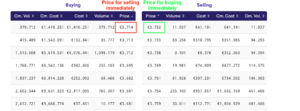Category
- Trading Academy
- Get Started
- Exchanges Guidelines
- Trading 101
- Master TradingView
Why Market Liquidity Matters
When building an automated trading strategy, not only do you have to make sure you create an effective trading system. You also need to make sure to apply it to the right asset. Assessing the market liquidity is a critical aspect that can have a significant impact on your trading performance. Why does market liquidity matter so much, especially when running an automated trading system?
The market liquidity may affect your trades, forcing you to buy at sub-optimal prices and causing sub-optimal executions when selling. The bid/ask spread is the main gauge of the liquidity of an asset. That’s why it’s essential to have a clear perception of why market liquidity matters. You can read more about the trading jargon here.
Market vs Limit orders
Market liquidity impacts how quickly you enter into a trade and, then, how easy it is to close it. In some cases, it may be expensive to open and close positions quickly if the liquidity of the market is poor. Let’s see what options traders have to buy and sell on the market.
The first concept you need to keep in mind is the difference between these two ways to trade assets.
A market order is an instruction to buy/sell at the best market conditions available in that specific moment, no matter what would be the final executed price.
Buying or selling at market allows you to trade in the quickest way possible, but it doesn’t guarantee the price at which your trade will be executed.
A limit order, instead, is an instruction to buy (sell) an asset but not at a price higher (lower) than the one specified.
Trading using limit orders guarantees you to avoid unexpected executed prices but could result in a delay of the fill, or, eventually, it could prevent a trade from being completed.
An automated traded strategy requires fast executions once the bot generates the trading signal. So a market order is the most appropriate choice. That means that you should avoid liquidity traps that could negatively affect your strategies.
How does market liquidity impact your automated strategies?
The market liquidity impacts your trading system, both creating false-signals that trigger the orders and resulting in execution at non-convenient prices.
The condition
If the bid/ask spread is large, each trade that will occur on the market will have a relatively significant percentage change from one order to the next.
Here you can see the order book of HOTBTC on Binance. The coin has a very low price, and since the minimum tick size is one Satoshi, it creates large price changes. If the last traded price is 6 sats and the following trade comes at 7 sat, that corresponds to a price change of 16%. That is for sure not a signal of a price rally for that coin!
If we try to plot Moving Averages and the RSI on the price chart of HOTBTC, clearly they don’t provide any useful signal that you can use for trading purposes.
Coins with very low prices, or with very low liquidity may present similar patterns and trading them with an automated trading system may result in unexpected losses.
The order
Not only large bid/ask spreads and low liquidity impact your trading system negatively by providing wrong signals, but they also cause orders to execute at inconvenient prices.
This is the order book of BTCEUR on Kraken, a very liquid exchange. As you can see, there is no relevant difference between the best bid and best ask price. You can buy and sell Bitcoin without encountering significant slippage of price.
Here is another example, in this case, you can see the order book of MLNEUR on the same exchange. The spread between bid and ask is roughly 0.5%. That means that if the bot signals a buy-order when the last traded price is 3.714, the actual price at which your trade will execute will be 3.732. Of course, if the size of your order is relatively large compared to the liquidity offered in the order book, the slippage effect will be larger as you will get executed at sequentially higher prices.
How does Coinrule solve the liquidity problem?
Our trading engine has some price filters in place that prevent triggers from activating if the price of the coin is very low.
For example, if you set a rule to execute if “any coin has price decrease by 10%”, the trading engine will exclude trading pairs like HOTBTC from being checked. If these filters weren’t in place, every time a trade occurs on the HOTBTC market, the condition would be met (as the spread between bid/ask is currently 16%), and the bot would send a market order that will likely result in losses for the trader.
This is a smart approach that allows the rule to trigger only if the price change has a specific trading relevance.
Another way to avoid buying less liquid coins is to add a filter for market capitalization when setting up your rule. Generally, coins with a high market cap have higher liquidity, and their order books present tight bid/ask spreads.
A rule like the one in the example above makes sure that all the coins that the bot will buy and sell meet an adequate liquidity standard which will improve the results of your strategy significantly!
There is a reason why Bitcoin, Ethereum or other major coins have such high trading volume. Traders love to trade them because they can jump in and out from trades at convenient prices, without incurring significant slippage. That’s the reason why market liquidity matters!
Nevertheless, there are many opportunities every day on the market across dozens of other relatively liquid coins.
Coinrule allows you to take advantage of all these opportunities with measures that help reduce the risk of trading less liquid coins.




